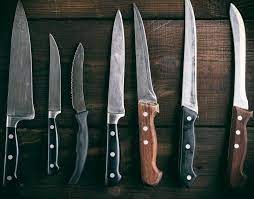Tips for buying kitchen knives guide, Home food cutting tool, Online cooking product advice
Tips for buying kitchen knives: advice
19 Apr 2021
Buying kitchen knives might seem easy to those unfamiliar with using the most commonly used cutting tool. However, users who are well aware of the intricacies of knife design and size with respect to its functionality would know that it is better to seek guidance in choosing kitchen knives by focusing on their extent of use and their specific purpose. Just as you need the right tools in a workshop to do a good fabrication job, in the same way, you need the right kind of kitchen knife to perform some cutting or peeling tasks.
Kitchen knives purchase
This guide for choosing the best kind of knife should make the task easy for you.
Build your inventory of kitchen knives
To start the process of selecting a kitchen knife, you must first consider your cooking needs. Also, factor in the amount and variety of food items you would generally handle so that you can narrow down the choice according to the use while enjoying your cooking sessions to the fullest.
Moreover, you must also consider the variety of cuisines that you usually prepare to figure out the ingredients, which will tell you the types of kitchen knives that you would need. Considering that the average household consumes meat, fish, dairy products, bread, and bakery items, your ideal inventory of kitchen knives should consist of a Chef Knife, Paring knife, and Bread knife or serrated knife.
If your family is more carnivorous, you must include a few more knives like the Boning knife, Steak knife, Carving knife, Fillet knife, and even a Cleaver if you handle heavy masses of meat. Again, if you love experimenting with various dishes of other countries, then adding a Mezzaluna knife, Sashimi knife, and Santoku knife becomes inevitable.
When you have too many knives in your kitchen, it would be sensible enough to add two more – Vegetable Knife and Cheese Knife.
The cost aspect
Although buying kitchen knives is never expensive, you must be sensitive to the cost to avoid wasting money. Although the price of knives is quite competitive, you must know what you are paying for by understanding the elements that impact the cost of knives. The manufacturing methods of knives influence their price and durability and retain the sharpness for a longer time.
Stamping and forging – Tips for buying kitchen knives
Stamping and forging are the two methods of producing knife blades.
Stamped knives – Knives made entirely by using machines use the stamping process. It consists of cutting out the knife blade from sheet metal by using a die-press. The knives have an excellent finish and are made from high-quality material with great designs that hold a distinctive edge. Some of these knives can be honed and hand-polished, and it costs lesser than the forged variety.
Forged knives – Forging consists of heating metals and hammering them to give the defined shape to the blade. The forging process can be manual or done with the help of automated machines but requires considerable skill to complete the process.
Forged knives perform better, last longer, and cost more than stamped knives.
Comments on this guide to Tips for buying kitchen knives article are welcome.
Edinburgh Architecture
RBGE Edinburgh Biomes
RBGE Edinburgh Biomes Construction
65 London Road
65 London Road Edinburgh
Comments on this Tips for buying kitchen knives advice article are welcome.
